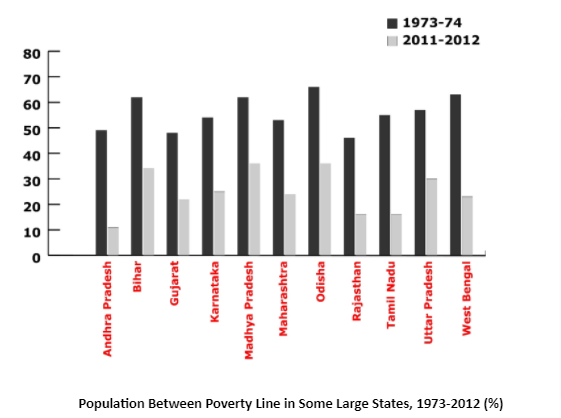What is Poverty?
Poverty is an economic condition in which people face a scarcity of certain commodities necessary for human survival, such as money and material goods. Poverty, as a result, is a multifaceted concept with social, economic, and political implications.
Poverty Line :
- A simple way to determine the poverty line is by the monetary value (per capita expenditure) of the minimum calorie intake of every person
- It was assessed at two thousand and four hundred calories for a rural individual and two thousand and one hundred calories for an individual in the metropolitan region
- In 2011-2012, the destitution line was characterized for provincial regions as utilisation worth Eight Hundred and sixteen rupees for each individual a month, and metropolitan areas, it was around one thousand rupees
- The public authority utilizes Monthly Per Capita Expenditure (MPCE) as an intermediary for families’ money to recognize poor people
What are the types of Poverty?
There are various ways to identify the type of poverty based on social, economic, and political factors:
Absolute Poverty
Extreme poverty, also known as abject poverty, is defined by a lack of basic food, clean water, health, shelter, education, and information. Those living in absolute poverty struggle to survive, and many children die as a result of preventable diseases such as malaria, cholera, and water-contamination-related diseases. Absolute poverty is unusual in developed countries.
Poverty in Relative Terms
From a social standpoint, it is defined as a living standard in comparison to the economic standards of the surrounding population. As a result, it is used to assess income inequality. A family may be considered poor if it cannot afford to take vacations or buy gifts for their children on their birthdays.
Situational Poverty
It is a type of poverty that occurs as a result of an adverse event such as an environmental disaster, job loss, or a severe health problem. People can help themselves even with small amounts of assistance, as poverty is the result of an unfortunate event.
Poverty Across Generations
It is passed down from generation to generation to individuals and families. This is more complicated because there is no way out because the people are trapped in the cause and lack access to the tools needed to escape.
Poverty in rural areas
It occurs in rural areas with fewer than 50,000 inhabitants. It is a region with fewer job opportunities, limited access to services, limited support for people with disabilities, and few opportunities for high-quality education. To make a living, most people rely on farming and other menial labour available in the surrounding area.
Poverty in Cities
It occurs in metropolitan areas with a population of more than 50,000 people. The following are some of the major challenges that the urban poor face:
- Inadequate access to health and education
- Affordability of housing and services
- Violent and unhealthy environment as a result of overcrowding
- Inadequate or non-existent social protection mechanisms
What Factors Affect Poverty Line:
- It considers all the poor as a whole without differentiating between the poor people and those who are extremely poor, thereby making it almost impossible to verify who needs the help the most.
- This mechanism considers the expenditure on food and a few select items as a proxy for income by economists as its basis.
- Other than income and resources, there are many elements related to neediness, such as the availability of essential schooling, medical care, drinking water, and disinfection. They should be considered to foster the Poverty Line.
- The current system doesn’t think about social factors that trigger and propagate neediness like ignorance, chronic sickness, absence of admittance to assets, segregation, or lack of standard and political opportunities.
- Researchers have endeavored to track down elective techniques because of different restrictions in the authorised assessment of neediness. For example, Amartya Sen, a noted Nobel Laureate, has fostered a list known as Sen Index.
The number of poor in India:
- The number of poor is estimated by the “Head Count Ratio,” which is the proportion of people below the poverty line.
- NITI Aayog made the official data on poverty public. It is assessed based on consumption information gathered by NSSO, short for National Sample Survey Organization, presently called the National Statistical Office.
- The number of poor reduced from 320 million in 1973-1974 to 270 million in 2011-2012.
- The percentage of poor has reduced from 55% in 1973-1974 to 22% in 2011-2012.
- More than 80% of the poor reside in rural areas, and this has not changed much.
Populace Between Poverty Line in Some Large States, 1973-2012 (in %)
- Six states from Bihar, Madhya Pradesh, West Bengal, Orissa, Tamil Nadu, and Uttar Pradesh, among others, contained a considerable part of the poor between the years 1973-1974.
- During the years 1973-2012, numerous Indian states decreased the neediness levels to a significant degree.
- However, the destitution levels in four states, such as Bihar, Uttar Pradesh, Odisha, and Madhya Pradesh are far beyond the public neediness level.

- Six states from Bihar, Madhya Pradesh, West Bengal, Orissa, Tamil Nadu, Uttar Pradesh, among others, contained a considerable part of the poor between the years 1973-1974.
- During the years 1973-2012, numerous Indian states decreased the neediness levels to a significant degree.
- However, the destitution levels from four states, such as Bihar, Uttar Pradesh, Odisha, and Madhya Pradesh are far beyond the public neediness level.
In Conclusion:-
Poverty in India can be eradicated. The first step would be to assist the poor in starting their own businesses so that they can generate their own income. The second step is to create jobs that will allow low-income people to increase their income through wages or salaries. Finally, selling products to the poor would enable them to earn or save money.
 Profile
Profile Settings
Settings Refer your friends
Refer your friends Sign out
Sign out












